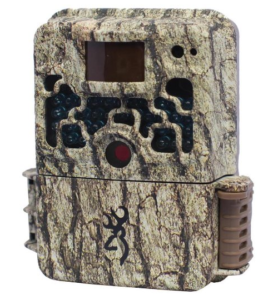 Trail cameras are rugged, weatherproof, remote cameras with long-lasting batteries that can be left unattended for months in remote areas, or in areas that are difficult or dangerous for a photographer to access. Remote cameras have a wide range of uses. Artists, nature photographers, and researchers use them for time-lapse photography. Homeowners, researchers, and hunters use them to observe wildlife. In sports photography, remote cameras might be placed behind a basketball hoop, on a goal, or beside a racetrack. They are used as web cams to display scenic views as well as to monitor equipment in hazardous areas. They are also used for security and surveillance by many.
Trail cameras are rugged, weatherproof, remote cameras with long-lasting batteries that can be left unattended for months in remote areas, or in areas that are difficult or dangerous for a photographer to access. Remote cameras have a wide range of uses. Artists, nature photographers, and researchers use them for time-lapse photography. Homeowners, researchers, and hunters use them to observe wildlife. In sports photography, remote cameras might be placed behind a basketball hoop, on a goal, or beside a racetrack. They are used as web cams to display scenic views as well as to monitor equipment in hazardous areas. They are also used for security and surveillance by many.
In this article we will break down the best trail cameras for you to use for your specific needs, as well how to use it properly.
Best Overall Trail/Game Camera
The Browning Strike Force Sub Micro ranks high on all features, and is our top choice. It captures daytime and nighttime photos and HD videos with sound. Daytime videos can last from five seconds to two minutes.
A fast trigger speed of 0.67 seconds and a recovery time of 2.3 seconds ranks it in the top five percent of all trail cameras on the market. Reviewers report that the camera captures head shots of animals as they enter the field of vision, full shots as they pass through, and “butt shots” as they leave, indicating that the field of vision consistently matches the camera’s 50 foot detection range.
In daylight, the camera’s light sensors easily handle direct sun, shade, or a mix of sun and shade, producing bright, clear images with excellent contrast.
The no-glow infrared flash for night photography emits no visible light, but some dimness, graininess, and blur is expected from these flashes. Reviewers report, however, that the contrast in the nighttime image is exceptional and that all areas of the image are evenly lighted. They could identify human faces and count the points on a large buck within a 50-foot detection range.
This trail camera uses six AA batteries. Lithium batteries provide approximately six months of battery life while rechargeable batteries provide about two months per recharge.
Camera setup is easy. The two-inch internal viewer with live preview mode allows you to see the area that is in the cameras field of view as you set it up. The camera’s size (5″ x 3.2″ x 2.5″ ) and the bark pattern printed on the case allow it to blend exceptionally well with tree bark.
Best Wireless/Cellular Trail Camera
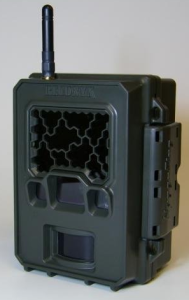 With the SC950 models, Reconyx enters the cellular trail camera market. Within 60 seconds of taking a photograph, the camera transmits a low-resolution version to either your cell phone or e-mail address.
With the SC950 models, Reconyx enters the cellular trail camera market. Within 60 seconds of taking a photograph, the camera transmits a low-resolution version to either your cell phone or e-mail address.
The camera has a trigger speed of 0.25 seconds and a recovery speed of 60+ seconds. As with all Reconyx cameras, the detection range of 70 feet perfectly matches the field of vision. The no-glow infrared flash extends to 50 feet.
Again as with all Reconyx cameras, the case is extremely durable, and at 5 1/2″ x 4 1/2″ x 3″, it is easy to conceal.
The full resolution photos stored on the camera’s SD card are clear and sharp with good contrast. Colors in daytime photos are excellent. However, the lower resolution photos sent to cell phones or e-mail are compressed to 512 pixels by 384 pixels. They will show cars, trucks, and people in areas where they should not be and provide a description of the type of vehicle, the size of a person, and the clothing worn. Daylight images will show colors. They will not show details such as facial features or license plate numbers, and you will not be able to enlarge or blow up the compressed images to show such details. You will need to retrieve the SD card. For that reason, you should be aware that, to allow for continuous operation, the camera uses Loop Recording, recording new images over the oldest ones if the SD card is not retrieved.
Power consumption during daytime and nighttime photography depends on how long it takes the camera to connect with the network and transmit the image. The resting current draw is very low at 22 milliamps. The median from a series of tests rates power consumption for daylight photography at 13,175 milliamps and 14,139 milliamps for nighttime photography. These figures are higher than other cellular trail cameras. If concealment is not an issue, consider purchasing the Reconyx Solar Panel. However, the camera can capture up to 40,000 images from one set of 12 AA batteries.
Basic camera setup is similar to other Reconyx cameras. When you order the cellular model, you will need to choose either AT&T or Verizon as the service provider for the camera. Reconyx installs the appropriate sim card and ships detailed instructions on sim card setup and the available rates and service plans. If you already have cell phone service from AT&T, you can simply add a new line for the camera. If you are not already an AT&T customer, you can use AT&T’s no-contract GoPhone Plan.
The camera comes with a CD of software that you will need to install on your computer for cellular setup. You can set the camera to send images to up to two e-mail addresses and four cell phone numbers. You can also have the camera send one photograph a day as proof that it remains operational. Unlike most cellular trail cameras, the Reconyx SC950C allows you to use two schedules to set times when the camera will operate and when it will not. If the camera is used for security, you can use one schedule to turn off the camera during work hours on work days and the other to set the camera for full-time operation on non-workdays.
The camera can also be set to take up to 10 images in burst mode at your choice of intervals. Instead of entering its recovery phase after taking each individual image, the camera takes and transmits the full set of images, providing up to 10 images of intruder activity.
This is a versatile camera that can be used for either security or wildlife observation. The price is high, but justifiable for security uses.
Best Camera for the Money
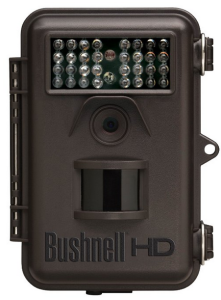 The Bushnell Trophy Cam HD Trail Camera with Night Vision has a trigger speed of 0.6 seconds with a detection range of 60 feet. A similar Bushnell Trophy Cam lists a recover speed of 2.9 seconds and a detection range of 50 feet. When set to automatic mode, the Passive Infra-Red (PIR) motion sensor monitors ambient temperature conditions and regulates the sensitivity of the trigger based on the temperature readings.
The Bushnell Trophy Cam HD Trail Camera with Night Vision has a trigger speed of 0.6 seconds with a detection range of 60 feet. A similar Bushnell Trophy Cam lists a recover speed of 2.9 seconds and a detection range of 50 feet. When set to automatic mode, the Passive Infra-Red (PIR) motion sensor monitors ambient temperature conditions and regulates the sensitivity of the trigger based on the temperature readings.
The camera is equipped with a day/night auto-sensor and can be set to take photos only during the day, only at night, or both day and night. Field Scan time-lapse mode allows the camera to take still photographs or videos at your choice of intervals independently of the motion trigger. Field Scan 2X allows two windows for photography or videos which is useful for capturing images during the magic hours of dusk and dawn. A similar Bushnell Trophy Cam stores videos as avi files, but, because it is not a true avi file, Mac computers require a free DIVX player to display the videos.
When triggered by the motion detector, the camera takes still photos or up to 60 seconds of video with sound both day and night with a video resolution of 1280 pixels by 780 pixels. Images are stamped with the date, time, phase of the moon, and the temperature. A GPS locator tag allows those with multiple cameras to input the longitude and latitude of the camera’s location and have that information embedded in the image file.
The nighttime red-glow infrared LED flash has a range of 60 feet. Some animals notice the flash, but are not frightened by it. A similar Bushnell Trophy Cam provides an adjustable nighttime flash with settings of low, medium, and high. Setting the flash lower shortens the exposure and darkens nighttime pictures, eliminating problems with motion blur and severe white out for objects within 10 feet of the camera. This setting also lengthens battery life. Daytime pictures are clear, sharp, and have excellent color. The video is also excellent and the audio is able to pick up sounds at some distance.
The camera uses four to eight AA batteries. A comparable Bushnell Trophy Cam used just 0.19 milliamps while resting. Daytime photography requires 403 milliamps while nighttime photography requires 685 milliamps. This ranks in the top 10 percent of all cameras for low power consumption. Batteries in the similar model could last from two to four months or up to six to 12 months if the camera takes few pictures. Battery life can be extended with the use of nimh rechargeable batteries.
The camera is user friendly and easy to setup. The case design is simple, durable, and with the Real Tree AP Camo design and a size of only 5 1/2″ x 4″ x 2 1/2″, it is very easy to conceal.
Best Trail Camera Under $100
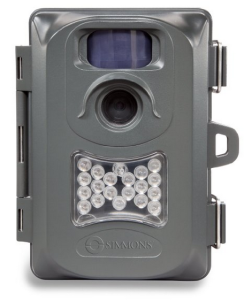 The Simmons Whitetail Trail Camera with Night Vision receives an average rating of 4.2 stars out of five stars from 93 reviewers on Amazon. The camera takes both daytime and nighttime photographs and videos. It can be set to a resolution of either five or six megapixels for still photos. Video resolution is 640 pixels by 480 pixels. The Passive Infra-Red (PIR) motion detector has a range of 30 feet, while the range of the red glow infrared night vision LED flash extends to 40 feet. One reviewer reports that the trigger speed is exceptional for cameras in the price range. The camera requires only four AA batteries, but battery life extends to six or seven months. The LCD screen makes setup simple.
The Simmons Whitetail Trail Camera with Night Vision receives an average rating of 4.2 stars out of five stars from 93 reviewers on Amazon. The camera takes both daytime and nighttime photographs and videos. It can be set to a resolution of either five or six megapixels for still photos. Video resolution is 640 pixels by 480 pixels. The Passive Infra-Red (PIR) motion detector has a range of 30 feet, while the range of the red glow infrared night vision LED flash extends to 40 feet. One reviewer reports that the trigger speed is exceptional for cameras in the price range. The camera requires only four AA batteries, but battery life extends to six or seven months. The LCD screen makes setup simple.
Most reviewers report satisfaction with the picture quality, but the images are not as sharp as those taken by eight megapixel cameras. The images are adequate for wildlife observation, but may not provide the detailed facial features that would allow easy identification of an intruder. Nighttime images appear to badly white out the center of the photo, especially for objects close to the camera.
Overall, however, most reviewers find that this camera fills their needs for inexpensive security or wildlife observation.
Best Trail Camera Under $200
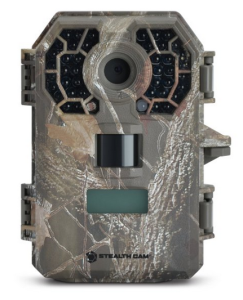 The Stealth Cam G42NG No-Glow Trail Game Camera receives an average rating of 4.3 stars out of five stars from 158 reviewers on Amazon. While the camera has a fast trigger speed of 0.49 seconds, it has a below average recovery time of 6.6 seconds. However, a firmware update is expected to reduce recovery time by half.
The Stealth Cam G42NG No-Glow Trail Game Camera receives an average rating of 4.3 stars out of five stars from 158 reviewers on Amazon. While the camera has a fast trigger speed of 0.49 seconds, it has a below average recovery time of 6.6 seconds. However, a firmware update is expected to reduce recovery time by half.
The camera has a detection range of 60 feet, and the no-glow infrared flash extends to 50 feet allowing the camera to monitor a wide area night and day.
The camera takes both still photos and HD videos with sound that range from five seconds to three minutes. Photo resolution can be set to two megapixels, four megapixels, eight megapixels, or 10 megapixels. Eight or 10 megapixels provide the most detail and the highest quality images. Animals close to the lens are in focus and there is little blurring, even with extensive motion. However, the background and objects more than 70 feet from the camera are out of focus. Interestingly, this is the opposite of most cameras. Daytime photos have vivid colors and good contrast, but some nighttime photos heavily white out objects close to the camera. A firmware update has improved nighttime photographs overall, but inconsistencies continue.
The camera uses eight AA batteries and requires 0.26 milliamps of current when resting, 646 milliamp seconds for daytime photography, and 1,475 milliamp seconds for nighttime photography. While the battery usage for daytime photography falls in the middle of the range when compared with the competition, the other two numbers are higher. Batteries will last three to six months, depending on the number of photographs taken. Lithium batteries work best. Alkaline batteries will work, but aren’t recommended. Nimh rechargeable batteries will not fire the infrared flash, so do not use them in this camera.
The case is well designed and measures only 5 1/2 inches by 4 inches by 2 3/4 inches. A bracket for a python lock and a threaded insert for a Slate River Mount are built into the case.
The camera can be set to take from one to nine photos in burst mode. It has three preset modes and one custom mode to choose from as well as a manual shot capability that is protected with a Secure Lock password. The preset modes include a three-photo burst at eight megapixels with a 30 second delay, a single photo at eight megapixels with a 30 second delay, and a 10 second HD video with audio at a 720 pixel resolution with a 10 second delay. When you move the slider to one of the preset modes, the backlit programming window lights up and the display scrolls through the settings for that mode. If you want a different setup, move the slider to custom mode and choose the settings you prefer.
This camera is a solid choice, but the slow recovery, higher power usage numbers, and inconsistent nighttime photographs are negatives to consider.
These trail cameras provide a range of options and prices for those seeking remote cameras for artistic purposes, security, or wildlife observation.
How Do I Select a Trail Camera?
When deciding which trail camera is best, the most important question is how you will use the camera. Will you take interior or exterior shots? Will you use the camera for nighttime photography as well as daytime photography? Are you using the camera for artistic purposes, sports photography, surveillance and security, or wildlife observation? Does the camera need to pan over an area or will it be fixed. Do you want still images, video, or both? Do you want a film camera, or do you want a digital camera with an SD card that can be left in place long term and that may be able to transmit images to your e-mail address or cell phone?
High quality images are important for any remote camera. Do not buy a camera with less than eight megapixels of resolution, especially if you intend to print the images.
Trigger speed is another important consideration. Camera used for sports photography, surveillance, or wildlife observation need a fast enough trigger speed to capture quick movements without blurring.
The range of the camera’s heat and motion sensors should match the camera’s field of view. When the trigger speed, the detection range, and the field of view work together properly, the camera should capture the person or animal that triggers the camera entering, passing through, and exiting the field of view.
The case of a camera used for wildlife observation or outdoor surveillance must be easily concealed, durable, and weatherproof, especially waterproof. It should have a sleek design with no protruding parts or controls that could be damaged.
The easier the camera is to use and the more simply it functions, the less likely it is that something will malfunction while the camera is unattended. The point of a wildlife observation camera is to reduce the presence of humans so that the animals behave normally, so it is important that both the camera’s battery life and its ability to continue to operate both extend for several months.
How to Use a Trail Camera
Braided safety cables and other mounting hardware secure remote cameras in areas where people might pass below. Gaffer tape and black wrap secure and protect camera cables. Surveillance cameras might be mounted on motorized brackets that pan over a wide area. Trail cameras are mounted in fixed positions and many have camouflage cases. Mounting these cameras at 30 inches captures images of deer and larger animals. A lower position captures smaller animals and game birds. Setting cameras to take three pictures in succession in “rapid fire” or “burst” mode captures fast moving animals without disturbing animals inclined to linger even when using a red-glow infrared flash that animals notice. Deer look in the direction of the flash but don’t flee. Predators such as coyotes and bobcats are more likely to be spooked. Purchasing a python lock or a security mount or box discourages theft of the camera.
Shutters on remote cameras can be triggered by a cable attached to a button, by radio remote, or, if the camera must operate independently of a photographer, by heat and motion sensors.
Check out this great video on the secrets of successfully using a trail camera:
